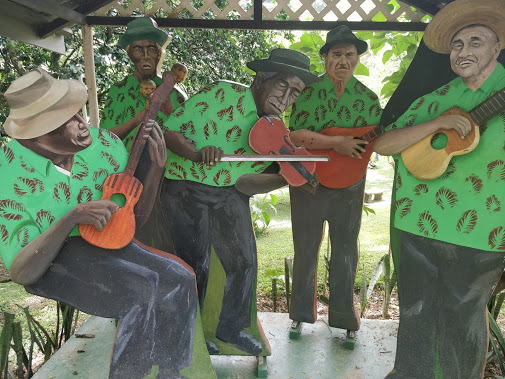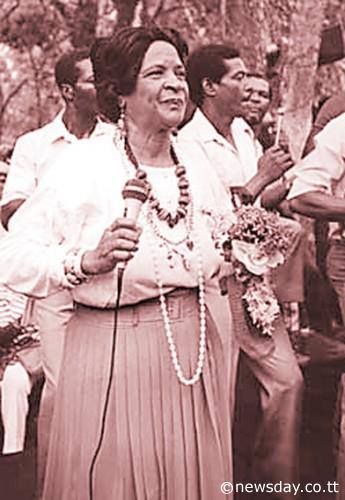Written by Joseph Bertrand, Education and Outreach Officer, National Trust of Trinidad and Tobago

Lopinot House (Image Source: Joseph Bertrand)
Feliz Navidad a todos! It’s Christmas time and what is a Trini Christmas without Parang? Parang is a style of music that is synonymous with the Christmas season in Trinidad and Tobago. This folk form evolved over time to incorporate singing from house to house and large corporate stages. Competitions and festivals highlight the parang music and create traditions that are part of this Trini Christmas. With this in mind, this blog looks at the versatility of parang and its connection to the heritage of Trinidad and Tobago.
Parang is heard mostly around Christmas time but did you know that it is not just Christmas music? Only two types of songs talk about the Annunciation and the Birth of Jesus Christ and a lot of the other popular songs are about secular topics. Take Rio Manzanare for example; this is about the River Manzanare that flows through Venezuela. But that is a discussion for another time. Today, let us look at how parang connects us to various aspects of the heritage of Trinidad and Tobago.

Dirt Oven (Image Source: Joseph Bertrand)
Traditionally, parang is sung in Spanish and it is part of Trinidad’s Spanish Heritage. The Spanish Heritage goes a bit deeper than language when talking about parang. During the period of 1498 – 1797 the Spanish colonized Trinidad and some areas where they established towns and mission villages are now hubs for parang. [1] For example, San Jose de Oruna, present day St Joseph is home to several parang bands such as San Jose Serenaders and Flores de San Jose and there is one of the largest Les Rois celebrations to end the Christmas Season.[2] Additionally, mission villages that became towns such as San Francisco de los Arenales (San Raphael), Santa Rosa De Lima (Arima) and La Divina Pastora (Siparia) are just a few major areas when talking parang.
We are also pointed to the connection with Trinidad’s Cocoa Heritage. Historian, Prof. Bridget Brereton states in her work Cocoa, the Golden Bean Cocoa and the Second Frontier (1870-1920) from: The Book of Trinidad that “Parang and the culture associated with it are inseparable from the cocoa peasantry.” The period from the 1880’s – 1920’s is considered the second golden age of Cocoa and Venezuelan peons came to Trinidad to work on the cocoa plantations. They brought their skills in cocoa cultivation, but they also brought their music and traditions. The “Cocoa Panyols” as they were called, sang their folk songs while playing various acoustic instruments which all form an integral part of parang in Trinidad.

Parang Band (Image Source: Joseph Bertrand)
The instruments used in a traditional parang band also connect us to various peoples and cultures that came to Trinidad. We can name a few of the instruments beginning with the Cuatro. This is the Venezuelan National Instrument that plays the chordal accompaniment for the band. Next, we have the maracas (chac-chac) which has roots in African cultures and First Peoples expressions and which provide a poly-rhythmic accompaniment that enhances the sound. The Box Bass is believed to have African roots and has developed over the years. It provides the bass tones for the band. The Mandolin and Violin are European influenced instruments, but they are played as lead instruments that would complement the melody of the song. In recent times the steel pan, the national instrument of Trinidad and Tobago has been used in parang by various bands to enhance the sound. Interestingly while not considered traditional, but still noteworthy is the use of the dhantal, which has Indian origins. This can be heard from the band La Divina Pastora, the band of the queen of parang Daisy Vosin.

The Parang Queen Daisy Voisin (Image Source: Newsday.co.tt)
Parang also is part of the character and identity of historical places in Trinidad. Lopinot and Paramin, are two communities that are nestled in the hills of the Northern Range. Parang is engrained in the traditions of these two communities. House to House parang is a feature that occurs in and out of the Christmas season in these areas and it is something special to witness as the camaraderie, love and happiness flows through the music into each home.

Portraits of Parranderos in the Lopinot Museum (Image Source: Joseph Bertrand)
So next time you listen to some parang music or take part in a socially distanced house-to-house parang, take a moment to appreciate these connections and these linkages. Parang is so much more than Christmas music. It is part of the Trinbago identity. It connects various aspects of Trinidad and Tobago’s heritage together to form this “Trini Christmas”.
Viva La Parranda!
Sources:
Brereton, Bridget. Cocoa, the Golden Bean Cocoa and the Second Frontier (1870-1920) from: The Book of Trinidad.
[1] Mission Village is a site where Indigenous Peoples were concentrated in order to extract labour and to convert them to Christianity.
[2] Les Rois – Lehwah the feast of the Three Kings. This Christian feast marks the end of the Christmas Season

